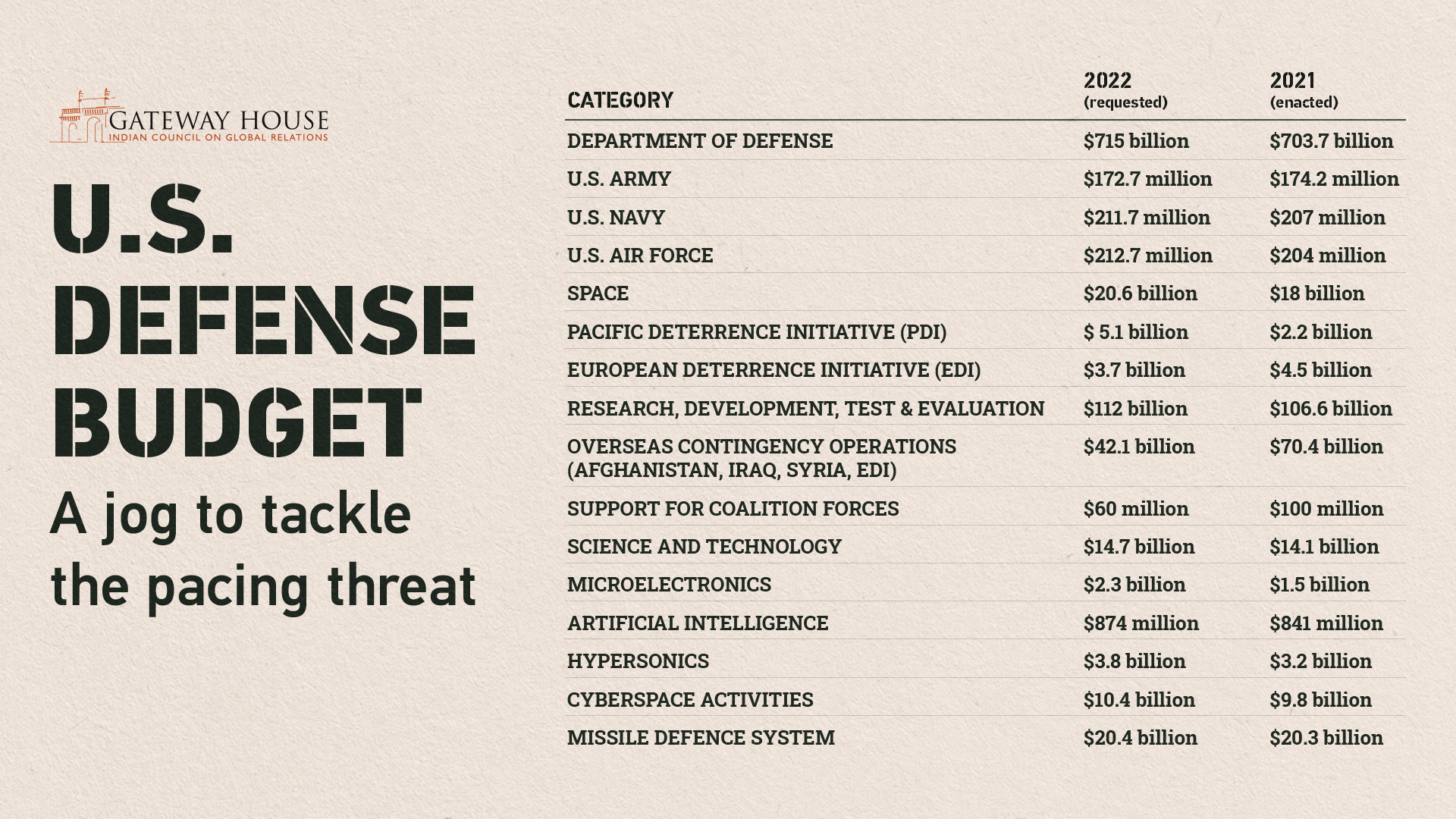The 2022, U.S. Defense Budget, if approved by Congress, will see $66 billion[1] (9.2% of the total budget) flow into the Indo-Pacific. This includes $ 5.1 billion for the Pacific Deterrence Initiative (PDI)[2].The latest request for PDI funding exceeds the European Deterrence Initiative (EDI) that has seen successive reduction from $ 6 billion in 2019 to the current request of $ 3.7 billion – a sign of growing defense expenditure by NATO and an increased U.S. focus on the Indo-Pacific.
The current budgetary request however, leaves more questions than answers regarding the U.S. capacity to challenge the pacing threat posed by China. For the last five years, with less than a third of the U.S. budgetary spending ($209 billion in 2021), China has built a significant military manufacturing industrial base – churning almost 20 major naval combatant platforms[3] and over 100 4th/5th generation fighter aircrafts every year– a sign of burgeoning Chinese shipbuilding capacities[4] and its scalability.
The 2022 U.S. budget request, meanwhile has cut down the previous administration’s plans for building of 12 naval platforms to eight of which only four are combat platforms[5]. This downsizing puts the U.S. Navy’s target[6] of 355 battle force ships between FY31 and FY33 in jeopardy. With China focused on near-sea operations while the U.S. operating more than 800 overseas military bases[7], questions on strategic overreach[8] and prioritization are bound to echo until the next budget request and finalization of global force posture review[9]. With over 95% of the 2022 PDI budget earmarked for upgrading Joint Force Lethality, the Indo-Pacific region is likely to see enhanced U.S. capabilities this year that aim to bolster deterrence and competitive advantage with China.
Designed by Debarpan Das.
This infographic was exclusively developed for Gateway House: Indian Council on Global Relations. You can read more exclusive content here.
For permission to republish, please contact outreach@gatewayhouse.in
© Copyright 2021 Gateway House: Indian Council on Global Relations. All rights reserved. Any unauthorised copying or reproduction is strictly prohibited.
References:
[1]https://comptroller.defense.gov/Portals/45/Documents/defbudget/FY2022/FY2022_Budget_Request_Overview_Book.pdf
[2]https://comptroller.defense.gov/Portals/45/Documents/defbudget/FY2022/fy2022_Pacific_Deterrence_Initiative.pdf
[3]https://fas.org/irp/agency/oni/plan-trends.pdf
[4]On 23 April this year, China commissioned three new ships on the same day – Type 094A ballistic missile submarine, Type 075 amphibious assault ship and Type 055 destroyer
[5]The U.S. Navy also has plans to retire 15 vessels, including four littoral combat ships, two submarines, seven cruisers, one dock landing ship, and a tug this fiscal.
[6]https://media.defense.gov/2020/Dec/10/2002549918/-1/-1/1/SHIPBUILDING%20PLAN%20DEC%2020_NAVY_OSD_OMB_FINAL.PDF
[7]https://www.fmprc.gov.cn/ce/cgmb/eng/fyrth/t1867692.htm
[8]USS Ronald Reagan, whose home port is in Yokosuka, Japan will head to Afghanistan in the next few days to assist withdrawal of forces. While it is away, the U.S. Navy will go without an aircraft carrier presence in the Pacific region in spite of a sizeable fleet of 11 air craft carriers at its disposal
[9]https://www.defense.gov/Newsroom/Releases/Release/Article/2494189/statement-by-secretary-of-defense-lloyd-j-austin-iii-on-the-initiation-of-a-glo/
